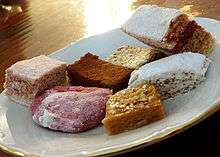Pastila
|
Pastila from Kolomna | |
| Course | Confectionery |
|---|---|
| Main ingredients | fruit purée, egg whites, sugar or honey |
| Variations | Food coloring |
|
| |
Pastila (Russian: пастила) is a traditional Russian fruit confectionery (pâte de fruits). It has been described as "small squares of pressed fruit paste"[1] and "light, airy puffs with a delicate apple flavor".[2] In Imperial Russia, the "small jellied sweetmeats" were served for tea "with a white foamy top, a bit like marshmallow, but tasting of pure fruit".[3]
The first mentions of pastila in Russian written sources date back to the 16th century.[4][5][6] The name is probably a loanword from Italian: pastello or pastiglia, or from the cognate French: pastille which in turn comes from Latin: pastillus (a loaf or pie, cf. pastilla).[4][7]
In the 19th century, pastila was made from sourish Russian apples such as Antonovka or mashed Northern berries (lingonberry, rowan, currants) sweetened with honey or sugar and lightened with egg whites. The paste was baked in the Russian oven for many hours, then arranged in several layers inside an alder box and then left to dry in the same oven.[8]
Kolomna claims to be the birthplace of original "white-foam" pastila and maintains a museum and a museum factory dedicated to history and traditions of pastila production.[9][10] The museum occupies a merchant house dating from ca. 1800, while the museum factory is located in a historical factory building. Rzhev and Belyov used to be known as other important centres of production.[8]
In Imperial Russia, pastila was considered an expensive treat. Priced at one rouble and a half, it was produced at noblemen's manors by serf labor. The cheapest pastila was made with honey instead of sugar. The Russian stove afforded two days of steadily diminishing heat to bake the fruit paste.[8] A Tatar variety was strained through a fine sieve, which helped keep apple seeds intact.[11]
In the Soviet period, pastila was produced using an industrially optimised technology.[12] According to William Pokhlyobkin, this Soviet-style pastila does not depend on the unique properties of the peasant stove and is markedly inferior to its homemade predecessors.[8] It was ultimately eclipsed in popularity by zefir, which is made from similar ingredients but with whipped egg whites and gelling agents.
See also
References
- ↑ Vera Broido. Daughter of Revolution: A Russian Girlhood Remembered. Constable, 1998. Page 122.
- ↑ Darra Goldstein. A Taste of Russia: A Cookbook of Russian Hospitality. Russian Information Services, 1999. ISBN 1880100428. Page 209.
- ↑ Christmas Around the World. Sutton Publishing, 1998. ISBN 9780750917247. Page 31.
- 1 2 М. Р. Фасмер. Этимологический словарь русского языка. Прогресс, 1964—1973. Пастила (Max Vasmer, Etymological dictionary of the Russian language).
- ↑ Послание Ивана Грозного в Кириллов монастырь, 1573 (The epistle of Ivan the Terrible to the abbot of the Kirillo-Belozersky Monastery, 1573).
- ↑ Домострой. глава 66 (Domostroy, a 16th-century Russian set of household rules. Section 66).
- ↑ А. Н. Чудинов. Словарь иностранных слов, вошедших в состав русского языка. 1910. Пастила (A. N. Tchudinov. Dictionary of foreign words adopted to the Russian language. 1910).
- 1 2 3 4 В. В. Похлёбкин. Кулинарный словарь. Центрполиграф, 2002 (William Pokhlyobkin. Culinary Dictionary. Centrpoligraf, 2002).
- ↑ Website of the Pastila Museum
- ↑ Website of the Pastila Museum Factory
- ↑ Леонид Васильевич Беловинский. Энциклопедический словарь российской жизни и истории: XVIII-начало XX в. ОЛМА-ПРЕСС, 2003. ISBN 5-224-04008-6. Сласти (Leonid Belovinsky, Encyclopaedic dictionary of Russian life and history: From the 18th to the beginning of the 20th century. OLMA-PRESS, 2003).
- ↑ ГОСТ-6441-96, Изделия кондитерские пастильные, общие технические условия (Interstate Standard 6441-96, former Soviet state technical standard, Pastila type confectionery. General specifications).
External links
-
 Media related to Pastila at Wikimedia Commons
Media related to Pastila at Wikimedia Commons - Paul Duvernet. Pastila: The delicacy of yesteryear, Russia Beyond the Headlines, Rossiyskaya Gazeta, 2011.
